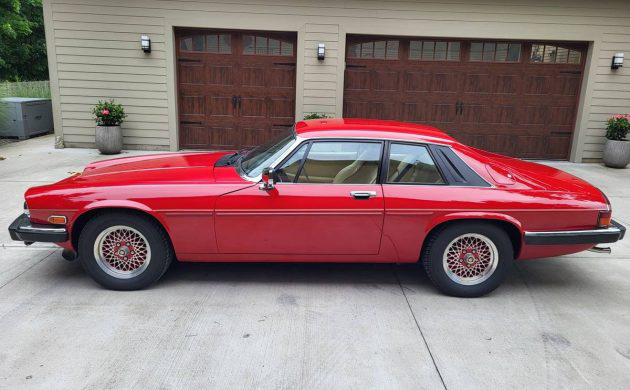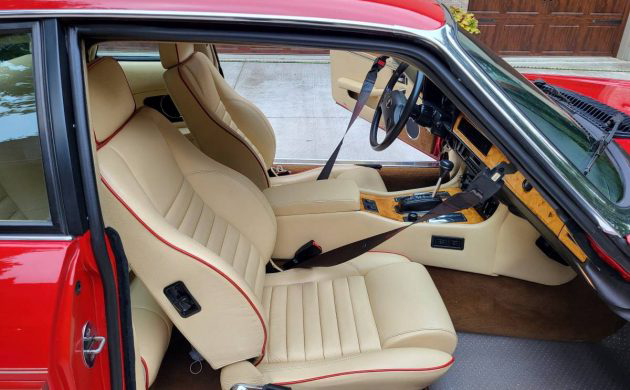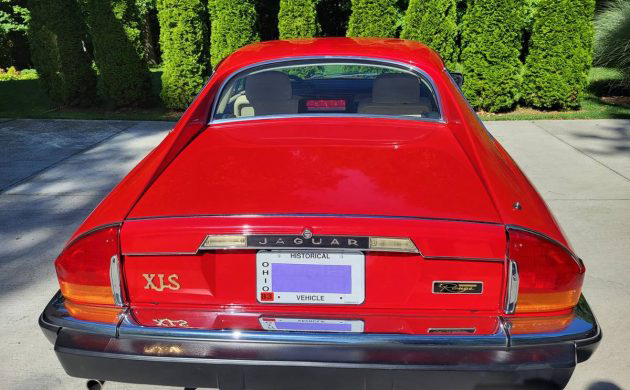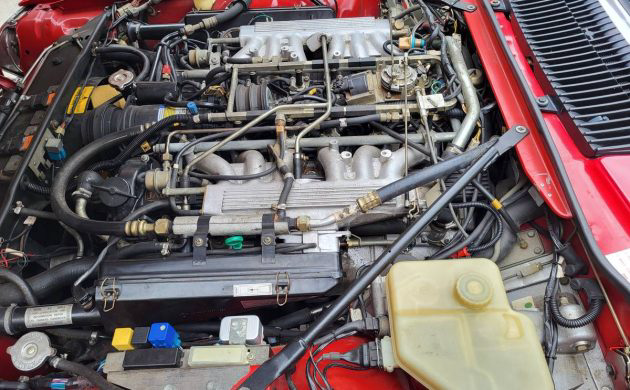The Jaguar XJS is a known quantity around these parts, and that carries with it both good and bad connotations. For the good, we know these are sometimes fiddly cars to maintain, and that the supply of poorly maintained examples handily outweighs the ones that were looked after. The availability of spares and parts cars is still quite good, and you can always swap in a domestic V8 for ease of daily use. The bad? Values are fairly stagnant, so bringing one up to snuff is a true labor of love; that said, a rare car like this 1-of-212 “Rouge” edition that’s clearly been loved is worthy of a closer look.
The Rouge models were effectively a bit of window dressing on an otherwise standard model. Color-keyed BBS-style wheels, red piping on the cream leather seats, and a discrete trunk badge highlighting its limited production status. The rest of the XJS is your standard issue fare, with a gorgeous two-door body, automatic transmission, woodgrain trim, and a massive V12 under the hood. This example shows just under 41,000 miles from new and comes with a few different goodies supporting its originality, including the factory tape cleaner kit and a matching full-size spare in the trunk.
I actually wrote one of these up a ways back here on Barn Finds that was actually found hidden away and in need of restoration. Part of me wonders if this is that same car, back on the market after a few years of reconditioning. This car comes with nicely preserved trim all around, from the black rubber bits to the chrome bumpers to the headlight lenses. This is what I was referring to earlier about the general state of XJS models: either they’ve been loved for decades by a British car aficionado or they’ve been left to rot by owners who didn’t have any sense of how much time and money it would require to maintain such a car.
The massive 5.3L V12 engine produced a respectable 263 horsepower when new, though that number would likely seem laughable compared to the displacement by today’s standards. The seller notes that this particular car has been refurbished with a new fuel tank (lending further speculation that this may, in fact, be the barn find car from a few years ago!) along with new front brakes/rotors/calipers/and pads. The shocks have also been replaced, and a rebuilt ABS master cylinder installed among several other updates. Find the Jaguar here on craigslist for $10,000 and thanks to Barn Finds reader Tony Primo for the find.






This looks like a very nice car for the money, complete with its original V12. Many folks swapped out the V12 for an LS conversion, but a fairly well-knownt YouTuber has done a twist-he’s shoe-horning a Jaguar V12 into a ’66 Chevelle!
The Rolls Royce Merlin sure wasn’t… Amazing that Britain built wonderful aircraft engines that helped win the war, and then built questionable cars for decades after.
I owned a ‘91 for 13 years. The motor itself is quite durable as long as it’s maintained. That especially means being diligent about the cooling system, as overheating can lead to a dropped valve, and the fuel rail, as failure of the small hoses can cause an engine fire.
Yup, the Jaguar V12 engine in general was a PITA. That’s why when most bought a Jag back then and knew the quirks, they went for the 6 cylinder. They did sell the XJS with the 6, but the majority were sold with the 12.
I had an inexpensive XJS with the V12.
When the engine is running correctly, it’s a real gem, so smooth you have to check the tach to make sure it’s running.
Gorgeous cars, stunning, and amazingly quick for a big, heavy car.
The weak parts are oil seals and Lucas electrics. Replacing oil seals is a massive project…and Lucas.
Lucas.
Need I say more?
The Jag V12 itself is actually an excellent engine, very stout, overbuilt even (but as stated above, don’t let it overheat!). It’s the ancillary stuff that gives it a bad name. There are fixes available to make them perfectly dependable now days. The OPUS ignition, for example – while state-of-the art when introduced, is a point of failure. It is easily and inexpensively replaced with a modern optical system. There are also inexpensive rebuilt kits available for the fuel injectors, thereby eliminating the risk of engine fire. I’ve owned three, so far, and intend to get another!
@tompdx: nice comments, especially the ignition & injectors.
I love the XJS. The moment I first saw one, I thought it was a stunning design, especially for the era. I remember the 500hp Tullius Group 44 XJS thrashing around race courses back in the late 70’s.
If I were convinced one was not a money vampire, I would consider another.
IMO, the XJS is a spectacular car for the money.
Years ago I knew a guy and his son who bought XJ6’s, and yanked the motor and trannies in them and replaced them with Cadillac 500 engines and transmissions. They sold them pretty quick too. I bought a 76 Sedan Deville off them for $2500.
I had a ’90 as a daily driver for several years. Bought it with 60,000 miles for $6,000, put $1,000 into it, eventually sold it for $7,000. Free transportation for three years.
I loved that car – the quality of the interior, the sheet metal, the heft of the doors – it was impressive. Complex, yes, and if it had needed major maintenance, expensive. It never stranded me, and was phenomenal on the highway. 100 mph and it was quiet, just cruising. Didn’t love the GM automatic, but I did like that if I kept my foot in it, it did not shift to third until 80 mph. Great torque, plenty of power. Not the most beautiful Jag – I now have a ’70 E-type, but the XJS is an easier driver. This one looks like a heck of a deal. $10k buys you a Subaru Outback with 150,000 miles these days. Or, you could have this car, a pleasure to drive, turns heads everywhere you go.
Sold already
I had an identical colors 1989 XJ-S identical to this one. It had 35k miles when I bought it and the Conolly beige leather still smelled new. It was fast from 55-150 mph and I surprised Porsches, SL500, and way pricier cars on the top end. I cruised across the SW desert at 100 mph for hours thanks to a big engine oil cooler. Passes everything but a gas station!
There is a secret to owning a Jaguar cheaply.
Do your own work! Avoid the over priced labor & parts charge.
A V12 works exactly like any other engine they are all 4 strokes have spark plugs, valves, pistons etc. the sole difference is 12 instead of 8,6, or 4.
They even use American sized wrenches. Parts are readily available for multiple sources.( don’t go near the dealer)
Plus unlike an V8 everything is on top so it’s easy to get at.
Power wise, they have 132 more horsepower than a Chevy 350 and 30 more horsepower than a 454. Tuned to English specs there is another 40 horsepower to pick up. All sorts of extra power available for peanuts.
The engine is really durable. Insanely well built. No shortcuts taken. If it stops it’s something simple. Test it like any other car. Does it have spark at the spark plugs? Good it’s not the GM IGNITION MODULE.
Is it getting fuel? Squirt some starting fluid in the air filter. If it tries to run then there are only a few things possible ( none expensive)
The transmission is a GM turbo 400 about as durable as any transmission ever made ( cheap to rebuild too! )
So true. I’ve owned 3 V12 Jags: a ’76 XJS, a 76 XJ12, and a ’74 E type. They were all very dependable, easy to work on – even though they look complicated. Just take a few photos of all that plumbing before you start taking things apart to get to whatever you’re working on, and it’s just like any other car.
Yes, it’s gone.
And if you wanted one of these, this was the one to get.